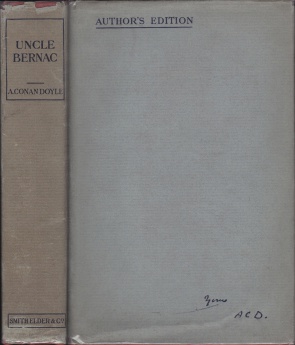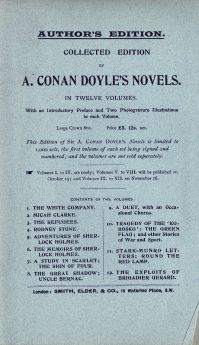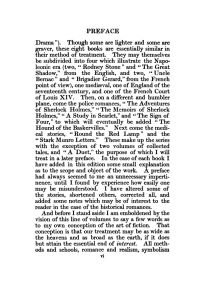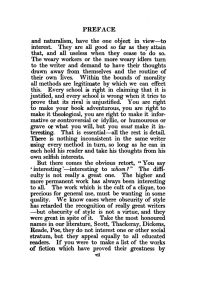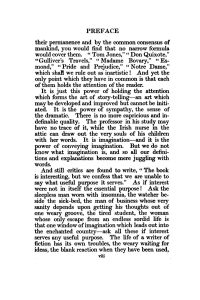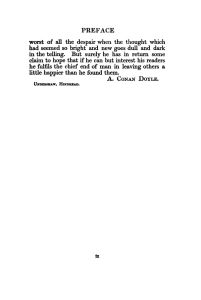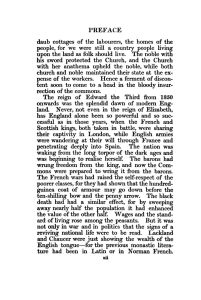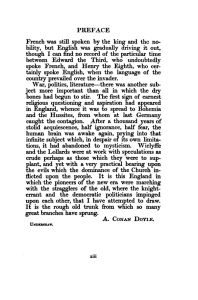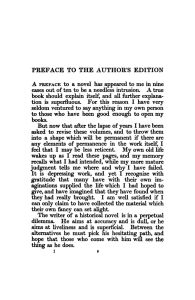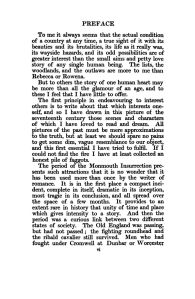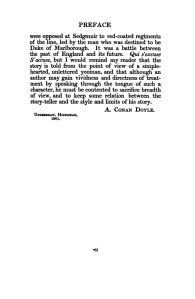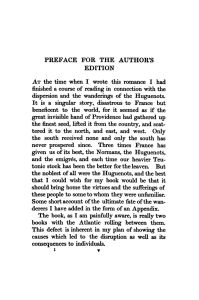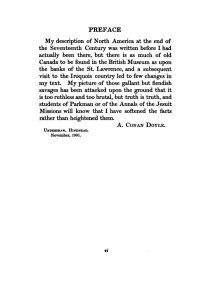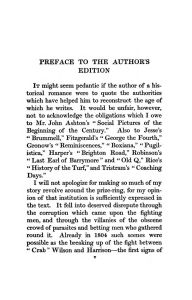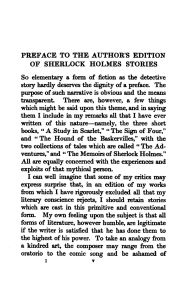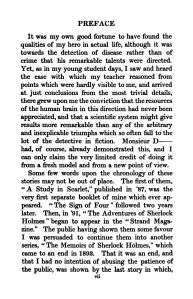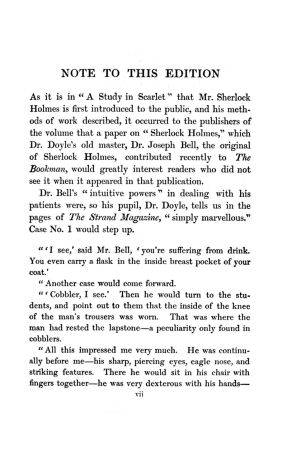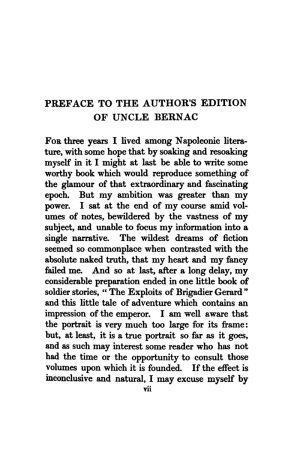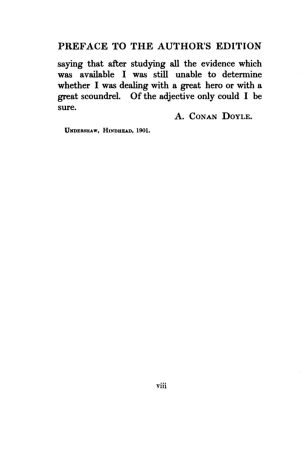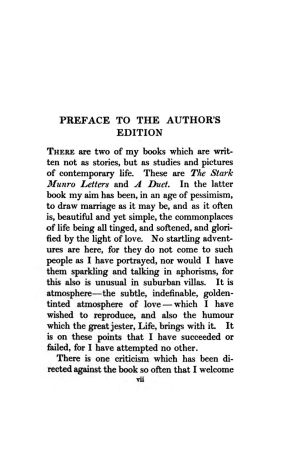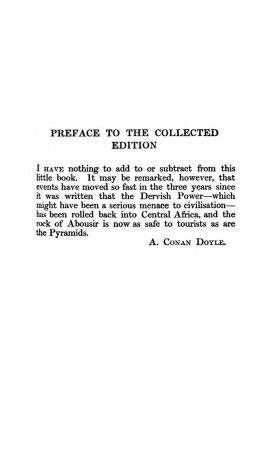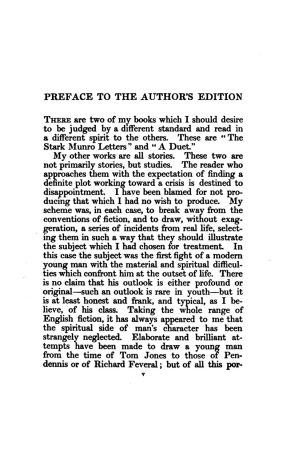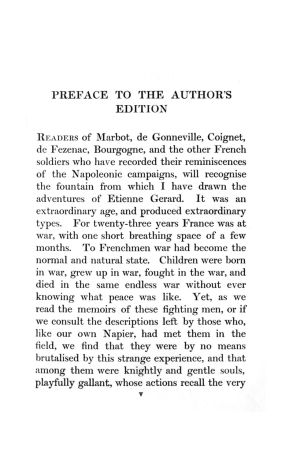Arthur Conan Doyle Author's Edition
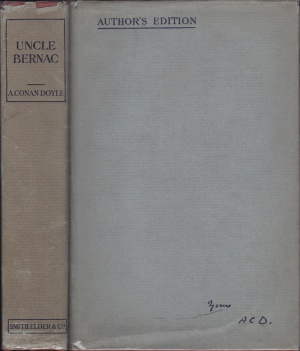
(Smith, Elder & Co.)
The Arthur Conan Doyle Author's Edition is a series of:
- 12 volumes published in UK by Smith, Elder & Co. (1903) and John Murray (reissued in 1917 but still marked 1903)
- 13 volumes published in USA by D. Appleton & Co. (1903)
Collecting Arthur Conan Doyle's stories written between 1891 and 1903. The 13 volumes hold 12 novels and 5 collected series (61 short stories).
US edition (D. Appleton & Co.) have only 1 frontispiece in each volume.
Stories
List sorted by Smith, Elder & Co.:
- 24.09.1903 : Vol. 01 : Prefaces, The White Company (2 ill. by Arthur Twidle)
- 24.09.1903 : Vol. 02 : Preface, Micah Clarke (2 ill. by Arthur Twidle)
- 24.09.1903 : Vol. 03 : Preface, The Refugees (2 ill. by Arthur Twidle)
- 24.09.1903 : Vol. 04 : Preface, Rodney Stone (2 ill. by Arthur Twidle)
- 15.10.1903 : Vol. 05 : Preface, Adventures of Sherlock Holmes (2 ill. by Arthur Twidle)
- 15.10.1903 : Vol. 06 : The Memoirs of Sherlock Holmes (2 ill. by Arthur Twidle)
- 15.10.1903 : Vol. 07 : A Study in Scarlet and The Sign of Four (2 ill. by Arthur Twidle)
- Note to this Edition (1893's note by Ward, Lock & Bowden)
- Mr. Sherlock Holmes, by Dr. Joseph Bell
- 15.10.1903 : Vol. 08 : Preface, The Great Shadow and Uncle Bernac (2 ill. by Arthur Twidle)
- 16.11.1903 : Vol. 09 : Preface, A Duet, with an Occasional Chorus (2 ill. by Arthur Twidle)
- 16.11.1903 : Vol. 10 : Preface, Tragedy of the Korosko and The Green Flag (1 ill. by Sidney Paget and 1 by Arthur Twidle)
- 16.11.1903 : Vol. 11 : Preface, The Stark Munro Letters and Round the Red Lamp (1 ill. by B. West Clinedinst and 1 by Arthur Twidle)
- 16.11.1903 : Vol. 12 : Preface, The Exploits of Brigadier Gerard (2 ill. by William B. Wollen)
in US edition only
- Volume 13 : The Hound of the Baskervilles (2 ill. by Sidney Paget)
Editions
- Author's Edition (24 september - 16 november 1903, Smith, Elder & Co. [UK]) 12 volumes
- Author's Edition (24 september 1903, D. Appleton & Co. [US]) 13 volumes
- Author's Edition (1917, John Murray [UK]) 12 volumes
-
List of volumes from Smith, Elder & Co..
Prefaces
Prefaces (Vol. 1)
Preface to the Author's Edition
Published in volume 1 "The White Company" (Smith, Elder & Co. and D. Appleton & Co., 1903).
-
p. v
-
p. vi
-
p. vii
-
p. viii
-
p. ix
PREFACE TO THE AUTHOR'S EDITION
It has always been my ambition — the dearer because it appeared to be unattainable — to have a collected edition of my own works. I have never, however, desired that that edition should be complete. On the contrary, the great charm of such a new departure was that it gave me an opportunity of finally casting off what my more mature judgment told me to be unworthy and of retaining what my conscience approved. That there should remain some twelve good-sized volumes will prove to some of my readers that that conscience is fairly elastic. For better, for worse, I have expended all pains in putting these books into their final form, and so I leave them. Outside this edition there is no work of mine up to this date which I do not willingly suppress.
For the help of any critic who may desire a clew as to a possible classification of these volumes, which deal in many ways with many subjects, I may suggest how they divide themselves in my own mind. There are, in the first place, the historical romances, which include "Micah Clarke," "The White Company," "The Great Shadow," "The Refugees," "Brigadier Gerard," "Rodney Stone," and "Uncle Bernac," together with what I may describe as the contemporary historical romance of "The Tragedy of the Korosko" (published in America under the name of "A Desert Drama"). Though some are lighter and some are graver, these eight books are essentially similar in their method of treatment. They may themselves be subdivided into four which illustrate the Napoleonic era (two, "Rodney Stone" and "The Great Shadow," from the English, and two, "Uncle Bernac" and "Brigadier Gerard," from the French point of view), one mediaeval, one of England of the seventeenth century, and one of the French Court of Louis XI V. Then, on a different and humbler plane, come the police romances, "The Adventures of Sherlock Holmes," "The Memoirs of Sherlock Holmes," "A Study in Scarlet," and "The Sign of Four," to which will eventually be added "The Hound of the Baskervilles." Next come the medical stories, "Round the Red Lamp" and the "Stark Munro Letters." These make up the series with the exception of two volumes of collected tales, and "A Duet," the purpose of which I will treat in a later preface. In the case of each book I have added in this edition some small explanation as to the scope and object of the work. A preface had always seemed to me an unnecessary impertinence, until I found by experience how easily one may be misunderstood. I have altered some of the stories, shortened others, corrected all, and added some notes which may be of interest to the reader in the case of the historical romances.
And before I stand aside I am emboldened by the vision of this line of volumes to say a few words as to my own conception of the art of fiction. That conception is that our treatment may be as wide as the heavens and as broad as the earth, if it does but attain the essential end of interest. All methods and schools, romance and realism, symbolism and naturalism, have the one object in view — to interest. They are all good so far as they attain that, and all useless when they cease to do so. The weary workers or the more weary idlers turn to the writer and demand to have their thoughts drawn away from themselves and the routine of their own lives. Within the bounds of morality all methods are legitimate by which we can effect this. Every school is right in claiming that it is justified, and every school is wrong when it tries to prove that its rival is unjustified. You are right to make your book adventurous, you are right to make it theological, you are right to make it informative or controversial or idyllic, or humourous or grave or what you will, but you must make it interesting. 'That is essential — all the rest is detail. There is nothing inconsistent in the same writer using every method in turn, so long as he can in each hold his reader and take his thoughts from his own selfish interests.
But there comes the obvious retort, "You say 'interesting' — interesting to whom?" The difficulty is not really a great one. The higher and more permanent work has always been interesting to all. The work which is the cult of a clique, too precious for general use, must be wanting in some quality. We know cases where obscurity of style has retarded the recognition of really great writers — but obscurity of style is not a virtue, and they were great in spite of it. Take the most honoured names in our literature, Scott, Thackeray, Dickens, Reade, Poe, they do not interest one or other social stratum, but they appeal equally to all educated readers. If you were to make a list of the works of fiction which have proved their greatness by their permanence and by the common consensus of mankind, you would find that no narrow formula would cover them. "Tom Jones," "Don Quixote," "Gulliver's Travels," "Madame Bovary," "Esmond," "Pride and Prejudice," "Notre Dame," which shall we rule out as inartistic! And yet the only point which they have in common is that each of them holds the attention of the reader.
It is just this power of holding the attention which forms the art of story-telling — an art which may be developed and improved but cannot be initiated. It is the power of sympathy, the sense of the dramatic. There is no more capricious and indefinable quality. The professor in his study may have no trace of it, while the Irish nurse m the attic can draw out the very souls of his children with her words. It is imagination — and it is the power of conveying imagination. But we do not know what imagination is, and so all our definitions and explanations become mere juggling with words.
And still critics are found to write, "The book is interesting, but we confess that we are unable to say what useful purpose it serves." As if interest were not in itself the essential purpose! Ask the sleepless man worn with insomnia, the watcher beside the sick-bed, the man of business whose very sanity depends upon getting his thoughts out of one weary groove, the tired student, the woman whose only escape from an endless sordid life is that one window of imagination which leads out into the enchanted country — ask all these if interest serves any useful purpose. The life of a writer of fiction has its own troubles, the weary waiting for ideas, the blank reaction when they have been used, worst of all the despair when the thought which had seemed so bright and new goes dull and dark in the telling. But surely he has in return some claim to hope that if he can but interest his readers he fulfils the chief end of man in leaving others a little happier than he found them.
A. CONAN DOYLE.
Undershaw, Hindhead.
Preface to the Present Edition
Published in volume 1 "The White Company" (Smith, Elder & Co., 1903).
-
p. xi
-
p. xii
-
p. xiii
PREFACE TO THE PRESENT EDITION
The England of which I write was a land of heath and of forest, full of waste places and wandering men. Across it from towns and shrines there stretched the great high roads, broad, ill-cared for, and deeply rutted, but far more used than any country roads are now. For the business and the pleasure of the country passed along these roads, and no man of consequence went either upon business or upon pleasure without others at his heels. On these narrow lines there was then constant bustle and crowding, but outside these strips of vivid life the country was dark and still. A few scattered towns gathered round the flanks of their castles and cathedrals. Here and there at Lon-don, in Norwich or at Bristol, commerce began to be a power and some dim dawnings of the future might have been seen by the discerning eye. Everywhere at the fords, and upon the hills, the stem towers of the warrior lords could be seen, not then dead and crumbling, a spectacle for the idle, but fiercely alive and alert, with blazoned banner flapping above, and steel caps glistening upon the wall. Numerous also were the fortresses of the Church, the mighty monasteries, once the refuges of piety and learning in an age of violence, but gradually materialising into the owners of one-third of the land and riches of England. And then scattered through the clearings and over the open plains there lay the rude widespread wooden houses of the farmers or franklins, and the wattle-and-daub cottages of the labourers, the homes of the people, for we were still a country people living upon the land as folk should live. The noble with his sword protected the Church, and the Church with her anathema upheld the noble, while both church and noble maintained their state at the expense of the workers. Hence a ferment of discontent soon to come to a head in the bloody insurrection of the commons.
The reign of Edward the Third from 1350 onwards was the splendid dawn of modern England. Never, not even in the reign of Elizabeth, has England alone been so powerful and so successful as in those years, when the French and Scottish kings, both taken in battle, were sharing their captivity in London, while English armies were wandering at their will through France and penetrating deeply into Spain. The nation was waking from the long torpor of the dark ages and was beginning to realise herself. The barons had wrung freedom from the king, and now the Com-mons were prepared to wring it from the barons. The French wars had raised the self-respect of the poorer classes, for they had shown that the hundred-guinea coat of armour may go down before the ten-shilling bow and the penny arrow. The black death had had a similar effect, for by sweeping away nearly half the population it had enhanced the value of the other half. Wages and the standard of living rose among the peasants. But it was not only in war and in politics that the signs of a reviving national life were to be read. Lackland and Chaucer were just showing the wealth of the English tongue — for the previous monastic literature had been in Latin or in Norman French. French was still spoken by the king and the nobility, but English was gradually driving it out, though I can find no record of the particular time between Edward the Third, who undoubtedly spoke French, and Henry the Eighth, who certainly spoke English, when the language of the country prevailed over the invader.
War, politics, literature — there was another subject more important than all in which the dry bones had begun to stir. The first sign of earnest religious questioning and aspiration had appeared in England, whence it was to spread to Bohemia and the Hussites, from whom at last Germany caught the contagion. After a thousand years of stolid acquiescence, half ignorance, half fear, the human brain was awake again, prying into that infinite subject which, in despair of its own limitations, it had abandoned to mysticism. Wiclyffe and the Lollards were at work with speculations as crude perhaps as those which they were to sup-plant, and yet with a very practical bearing upon the evils which the dominance of the Church inflicted upon the people. It is this England in which the pioneers of the new era were marching with the stragglers of the old, where the knight-errant and the democratic politicians impinged upon each other, that I have attempted to draw. It is the rough old trunk from which so many great branches have sprung.
A. CONAN DOYLE.
Undershaw.
Preface (Vol. 2)
Published in volume 2 "Micah Clarke" (Smith, Elder & Co. and D. Appleton & Co., 1903).
-
p. v
-
p. vi
-
p. vii
PREFACE TO THE AUTHOR'S EDITION
A preface to a novel has appeared to me in nine cases out of ten to be a needless intrusion. A true book should explain itself, and all further explanation is superfluous. For this reason I have very seldom ventured to say anything in my own person to those who have been good enough to open my books.
But now that after the lapse of years I have been asked to revise these volumes, and to throw them into a shape which will be permanent if there are any elements of permanence in the work itself, I feel that I may be less reticent. My own old life wakes up as I read these pages, and my memory recalls what I had intended, while my more mature judgment tells me where and why I have failed. It is depressing work, and yet I recognize with gratitude that many have with their own imaginations supplied the life which I had hoped to give, and have imagined that they have found when they had really brought. I am well satisfied if I can only claim to have collected the material which their own fancy can set alight.
The writer of a historical novel is in a perpetual dilemma. He aims at accuracy and is dull, or he aims at liveliness and is superficial. Between the alternatives he must pick his hesitating path, and hope that those who come with him will see the thing as he does.
To me it always seems that the actual condition of a country at any time, a true sight of it with its beauties and its brutalities, its life as it really was, its wayside hazards, and its odd possibilities are of greater interest than the small aims and petty love story of any single human being. The lists, the woodlands, and the outlaws are more to me than Rebecca or Rowena
But to others the story of one human heart may be more than all the glamour of an age, and to these I feel that I have little to offer.
The first principle in endeavouring to interest others is to write about that which interests one-self, and so I have drawn in this picture of the seventeenth century those scenes and characters of which I have loved to read and dream. All pictures of the past must be mere approximations to the truth, but at least we should spare no pains to get some dim, vague resemblance to our object, and this first essential I have tried to fulfil. If I could not find the fire I have at least collected an honest pile of faggots.
The period of the Monmouth Insurrection presents such attractions that it is no wonder that it has been used more than once by the writer of romance. It is in the first place a compact incident, complete in itself, dramatic in its inception, most tragic in its conclusion, and all spread over the space of a few months. It provides to an extent rare in history that unity of time and place which gives intensity to a story. And then the period was a curious link between two different states of society. The Old England was passing, but had not passed the fighting roundhead and the ribald cavalier still survived. Men who had fought under Cromwell at Dunbar or Worcester were opposed at Sedgmuir to red-coated regiments of the line, led by the man who was destined to be Duke of Marlborough. It was a battle between the past of England and its future. Qui s'excuse S'accuse, but I would remind my reader that the story is told from the point of view of a simple-hearted, unlettered yeoman, and that although an author may gain vividness and directness of treatment by speaking through the tongue of such a character, he must be contented to sacrifice breadth of view, and to keep some relation between the story-teller and the style and limits of his story.
A. CONAN DOYLE.
Undershaw, Hindhead, 1901.
Preface (Vol. 3)
Published in volume 3 "The Refugees" (Smith, Elder & Co. and D. Appleton & Co., 1903).
-
p. v
-
p. vi
PREFACE FOR THE AUTHOR'S EDITION
At the time when I wrote this romance I had finished a course of reading in connection with the dispersion and the wanderings of the Huguenots. It is a singular story, disastrous to France but beneficent to the world, for it seemed as if the great invisible hand of Providence had gathered up the finest seed, lifted it from the country, and scattered it to the north, and east, and west. Only the south received none and only the south has never prospered since. Three times France has given us of its best, the Normans, the Huguenots, and the emigres, and each time our heavier Teutonic stock has been the better for the leaven. But the noblest of all were the Huguenots, and the best that I could wish for my book would be that it should bring home the virtues and the sufferings of these people to some to whom they were unfamiliar. Some short account of the ultimate fate of the wanderers I have added in the form of an Appendix.
The book, as I am painfully aware, is really two books with the Atlantic rolling between them. This defect is inherent in my plan of showing the causes which led to the disruption as well as its consequences to individuals.
My description of North America at the end of the Seventeenth Century was written before I had actually been there, but there is as much of old Canada to be found in the British Museum as upon the banks of the St. Lawrence, and a subsequent visit to the Iroquois country led to few changes in my text. My picture of those gallant but fiendish savages has been attacked upon the ground that it is too ruthless and too brutal, but truth is truth, and students of Parkman or of the Annals of the Jesuit Missions will know that I have softened the facts rather than heightened them.
A. CONAN DOYLE.
Undershaw, Hindhead.
November, 1901.
Preface (Vol. 4)
Published in volume 4 "Rodney Stone" (Smith, Elder & Co. and D. Appleton & Co., 1903).
-
p. v
-
p. vi
PREFACE TO THE AUTHOR'S EDITION
It might seem pedantic if the author of a historical romance were to quote the authorities which have helped him to reconstruct the age of which he writes. It would be unfair, however, not to acknowledge the obligations which I owe to Mr. John Ashton's "Social Pictures of the Beginning of the Century." Also to Jesse's "Brummell," Fitzgerald's "George the Fourth," Gronow's "Reminiscences," "Boxiana," "Pugilistica," Harper's "Brighton Road," Robinson's "Last Earl of Barrymore" and "Old Q," Rice's "History of the Turf," and Tristram's "Coaching Days." I will not apologize for making so much of my story revolve around the prize-ring, for my opinion of that institution is sufficiently expressed in the text. It fell into deserved disrepute through the corruption which came upon the fighting men, and through the villanies of the obscene crowd of parasites and betting men who gathered round it. Already in 1804 such scenes were possible as the breaking up of the fight between "Crab" Wilson and Harrison — the first signs of the decay which was destined to permeate the whole. But in that fighting age, when the very existence of the country depended upon the rough valour of her sons, everything which made for hardihood and endurance was of national im-portance, and the prize-ring, rough and brutal as it was, served at least as a correction to effeminacy, and as an object lesson in manliness. I have added a note at the end of this volume, which gives a short account of some of the fighting-men who are mentioned in the course of the narrative, and may be of interest to those to whom the pages of "Pugilistica" are inaccessible.
A. CONAN DOYLE.
Undershaw, Hindhead,
1901.
Preface (Vol. 5)
Published in volume 5 "The Adventures of Sherlock Holmes" (Smith, Elder & Co. and D. Appleton & Co., 1903).
-
p. v
-
p. vi
-
p. vii
-
p. viii
PREFACE TO THE AUTHOR'S EDITION OF SHERLOCK HOLMES STORIES
So elementary a form of fiction as the detective story hardly deserves the dignity of a preface. The purpose of such narrative is obvious and the means transparent. There are, however, a few things which might be said upon this theme, and in saying them I include in my remarks all that I have ever written of this nature — namely, the three short books, "A Study in Scarlet," "The Sign of Four," and "The Hound of the Baskervilles," with the two collections of tales which are called "The Adventures," and "The Memoirs of Sherlock Holmes." All are equally concerned with the experiences and exploits of that mythical person.
I can well imagine that some of my critics may express surprise that, in an edition of my works from which I have rigorously excluded all that my literary conscience rejects, I should retain stories which are cast in this primitive and conventional form. My own feeling upon the subject is that all forms of literature, however humble, are legitimate if the writer is satisfied that he has done them to the highest of his power. To take an analogy from a kindred art, the composer may range from the oratorio to the comic song and be ashamed of neither, so long as his work in each is as honest as he can make it. It is insincere work, scamped work, work which is consciously imitative, which a man should voluntarily suppress before time saves him the trouble. As to work which is unconsciously imitative, it is not to be expected that a man's style and mode of treatment should spring fully formed from his own brain. The most that he can hope is that as he advances the outside influences should decrease and his own point of view become clearer and more distinctive.
Edgar Allan Poe, who, in his carelessly prodigal fashion, threw out the seeds from which so many of our present forms of literature have sprung, was the father of the detective tale, and covered its limits so completely that I fail to see how his followers can find any fresh ground which they can confidently call their own. For the secret of the thinness and also of the intensity of the detective story is, that the writer is left with only one quality, that of intellectual acuteness, with which to endow his hero. Everything else is outside the picture and weakens the effect. The problem and its solution must form the theme, and the character-drawing be limited and subordinate. On this narrow path the writer must walk, and he sees the footmarks of Poe always in front of him. He is happy if he ever finds the means of breaking away and striking out on some little side-track of his own.
It was my own good fortune to have found the qualities of my hero in actual life, although it was towards the detection of disease rather than of crime that his remarkable talents were directed. Yet, as in my young student days, I saw and heard the ease with which my teacher reasoned from points which were hardly visible to me, and arrived at just conclusions from the most trivial details, there grew upon me the conviction that the resources of the human brain in this direction had never been appreciated, and that a scientific system might give results more remarkable than any of the arbitrary and inexplicable triumphs which so often fall to the lot of the detective in fiction. Monsieur D——— had, of course, already demonstrated this, and I can only claim the very limited credit of doing it from a fresh model and from a new point of view.
Some few words upon the chronology of these stories may not be out of place. The first of them, "A Study in Scarlet," published in '87, was the very first separate booklet of mine which ever appeared. "The Sign of Four" followed two years later. Then, in '91, "The Adventures of Sherlock Holmes" began to appear in the "Strand Magazine." The public having shown them some favour I was persuaded to continue them into another series, "The Memoirs of Sherlock Holmes," which came to an end in 1893. That it was an end, and that I had no intention of abusing the patience of the public, was shown by the last story in which, wisely or unwisely, I brought my hero as well as my stories to an end. The subject had begun to weary me, and it seemed to me that, while there was no reason to be ashamed of doing detective stories, it was unjustifiable that I should allow my-self to be tempted into doing nothing else. "The Hound of the Baskervilles" represents the inevitable relapse after repentance.
One strong objection to the detective story has always been that it must deal with crime, and that the idea of crime is not a wholesome one for the young. It must be admitted that there is some force in this contention. If no crime were ever committed in these stories the reader might feel that he was the victim of a practical joke, but, it is a fact (never observed, as far as I remember, by any critic), that in a considerable number of these stories the effect is produced by the anticipation of what might have been, not of what is, and that there has actually been no grave legal crime whatever.
A. CONAN DOYLE.
Undershaw, Hindhead, 1901.
Note (Vol. 7)
Published in volume 7 "A Study in Scarlet and The Sign of Four" (Smith, Elder & Co. and D. Appleton & Co., 1903).
-
p. vii
-
p. viii
NOTE TO THIS EDITION
As it is in "A Study in Scarlet" that Mr. Sherlock Holmes is first introduced to the public, and his methods of work described, it occurred to the publishers of the volume that a paper on "Sherlock Holmes," which Dr. Doyle's old master, Dr. Joseph Bell, the original of Sherlock Holmes, contributed recently to The Bookman, would greatly interest readers who did not see it when it appeared in that publication.
Dr. Bell's "intuitive powers" in dealing with his patients were, so his pupil, Dr. Doyle, tells us in the pages of The Strand Magazine, "simply marvellous." Case No. 1 would step up.
"'I see,' said Mr. Bell, 'you're suffering from drink. You even carry a flask in the inside breast pocket of your coat.'
"Another case would come forward.
"'Cobbler, I see.' Then he would turn to the students, and point out to them that the inside of the knee of the man's trousers was worn. That was where the man had rested the lapstone — a peculiarity only found in cobblers.
"All this impressed me very much. He was continually before me — his sharp, piercing eyes, eagle nose, and striking features. There he would sit in his chair with fingers together — he was very dexterous with his hands — and just look at the man or woman before him. He was most kind and painstaking with the students — a real good friend — and when I took my degree and went to Africa the remarkable individuality and discriminating tact of my old master made a deep and lasting impression on me, though I had not the faintest idea that it would one day lead me to forsake medicine for story-writing."
That it did lead Dr. Doyle "to forsake medicine for story-writing," and with what result, every one knows. And as Mr. Sherlock Holmes has now become a household word and almost a public institution, the publishers of "A Study in Scarlet" hope that the following paper, in which some particulars of Dr. Doyle's early education and training, and of the circumstances which led him to form the habit of making careful observations, will prove of interest to his many readers. Their cordial thanks are due to Dr. Doyle, Dr. Bell, and to the editor and proprietors of The Bookman, for courteously consenting to the reproduction of the paper.
Preface (Vol. 8)
Published in volume 8 "The Great Shadow and Uncle Bernac" (Smith, Elder & Co. and D. Appleton & Co., 1903).
-
p. vii
-
p. viii
PREFACE TO THE AUTHOR'S EDITION OF UNCLE BERNAC
Fox three years I lived among Napoleonic literature, with some hope that by soaking and resoaking myself in it I might at last be able to write some worthy book which would reproduce something of the glamour of that extraordinary and fascinating epoch. But my ambition was greater than my power. I sat at the end of my course amid volumes of notes, bewildered by the vastness of my subject, and unable to focus my information into a single narrative. The wildest dreams of fiction seemed so commonplace when contrasted with the absolute naked truth, that my heart and my fancy failed me. And so at last, after a long delay, my considerable preparation ended in one little book of soldier stories, "The Exploits of Brigadier Gerard" and this little tale of adventure which contains an impression of the emperor. I am well aware that the portrait is very much too large for its frame: but, at least, it is a true portrait so far as it goes, and as such may interest some reader who has not had the time or the opportunity to consult those volumes upon which it is founded. If the effect is inconclusive and natural, I may excuse myself by saying that after studying all the evidence which was available I was still unable to determine whether I was dealing with a great hero or with a great scoundrel. Of the adjective only could I be sure.
A. CONAN DOYLE.
Undershaw, Hindhead, 1901.
Preface (Vol. 9)
Published in volume 9 "A Duet, with an Occasional Chorus" (Smith, Elder & Co. and D. Appleton & Co., 1903).
-
p. vii
-
p. viii
PREFACE TO THE AUTHOR'S EDITION
There are two of my books which are written not as stories, but as studies and pictures of contemporary life. These are The Stark Munro Letters and [[[A Duet, with an Occasional Chorus|A Duet]]. In the latter book my aim has been, in an age of pessimism, to draw marriage as it may be, and as it often is, beautiful and yet simple, the commonplaces of life being all tinged, and softened, and glorified by the light of love. No startling adventures are here, for they do not come to such people as I have portrayed, nor would I have them sparkling and talking in aphorisms, for this also is unusual in suburban villas. It is atmosphere — the subtle, indefinable, golden-tinted atmosphere of love — which I have wished to reproduce, and also the humour which the great jester, Life, brings with it. It is on these points that I have succeeded or failed, for I have attempted no other.
There is one criticism which has been directed against the book so often that I welcome an opportunity of saying a word upon it. The Violet Wright episode has been pronounced to be needless and offensive. In view of the respect which I have for some who entertain this view, I have gone over that part of the book and softened down some crudities, but, in the main, the chapters must remain as they stand. To excise them would be to weaken the reality and humanity of the book. I did not set out to write a fairy-tale, but to draw a living couple with all the weaknesses, temptations, and sorrows which might come to test their characters and to overshadow their lives. Frank is no ideal hero, but an every-day youth no better than his fellows. I cannot think that an episode which tends to show how the influence of a good woman may help a man to keep straight, or how in a direct duel the force of sincerity and virtue may overcome strength and brilliancy, can tend to anything but good.
A. CONAN DOYLE.
Undershaw, Hindhead,
1901.
Preface (Vol. 10)
Published in volume 10 "Tragedy of the Korosko and The Green Flag" (Smith, Elder & Co. and D. Appleton & Co., 1903).
-
p. i
PREFACE TO THE COLLECTED EDITION
I have nothing to add to or subtract from this little book. It may be remarked, however, that events have moved so fast in the three years since it was written that the Dervish Power — which might have been a serious menace to civilisation — has been rolled back into Central Africa, and the rock of Abousir is now as safe to tourists as are the Pyramids.
A. CONAN DOYLE.
Preface (Vol. 11)
Published in volume 11 at the beginning of "The Stark Munro Letters" section (Smith, Elder & Co. and D. Appleton & Co., 1903).
-
p. v
-
p. vi
PREFACE TO THE AUTHOR'S EDITION
There are two of my books which I should desire to be judged by a different standard and read in a different spirit to the others. These are "The Stark Munro Letters" and "[[[A Duet, with an Occasional Chorus|A Duet]]."
My other works are all stories. These two are not primarily stories, but studies. The reader who approaches them with the expectation of finding a definite plot working toward a crisis is destined to disappointment. I have been blamed for not producing that which I had no wish to produce. My scheme was, in each case, to break away from the conventions of fiction, and to draw, without exaggeration, a series of incidents from real life, selecting them in such a way that they should illustrate the subject which I had chosen for treatment. In this case the subject was the first fight of a modern young man with the material and spiritual difficulties which confront him at the outset of life. There is no claim that his outlook is either profound or original — such an outlook is rare in youth — but it is at least honest and frank, and typical, as I believe, of his class. Taking the whole range of English fiction, it has always appeared to me that the spiritual side of man's character has been strangely neglected. Elaborate and brilliant attempts have been made to draw a young man from the time of Tom Jones to those of Pendennis or of Richard Feveral; but of all this portrait gallery of young men, how many are there who indicate their relation to those eternal problems which are really the touchstone and centre of all character? One learns the smallest details of life and manners, while we are left ignorant of that which is the key both to the one and the other. It would be a gross presumption to suppose that this sketch fills the vacancy; but at least it points the way on which another may venture with more success. But I repeat that the object of the book is not to tell a story, but to give a faithful rendering of a modern young man with his relations to life.
A. CONAN DOYLE.
Undershaw, Hindhead.
Published in volume 11 at the beginning of the "Round the Red Lamp" section (Smith, Elder & Co. and D. Appleton & Co., 1903).
-
p. v
PREFACE TO THE AUTHOR'S EDITION
These stories have all some bearing, more or less direct, upon medical men and medical subjects. In looking over them I am struck by the fact that within the covers of one book I have used two entirely different methods of literary treatment. Five of the stories, "His First Operation," "The Third Generation," "The Curse of Eve," "A Medical Document," and "The Surgeon Talks," are strictly — some would say too strictly — realistic. The others are all tinged with romance. Holding, as I do, that the ultimate object of all fiction is interest, and that it is immaterial by what method or device you gain your end, so long as you do gain it, I have not concerned myself about this variety of treatment, and I have hoped that it might even have a good effect, since the lighter papers may relieve the intolerable grimness of medical truth. One of the short sketches, "A Straggler of '15," has had the good fortune to furnish Sir Henry Irving with the materials for his "Story of Waterloo," in which a great artist has shown how much may be made of the slightest of studies.
A. CONAN DOYLE.
Undershaw, Hinhead, 1901.
Preface (Vol. 12)
Published in volume 12 "The Exploits of Brigadier Gerard" (Smith, Elder & Co. and D. Appleton & Co., 1903).
-
p. v
-
p. vi
PREFACE TO THE AUTHOR'S EDITION
Readers of Marbot, de Gonneville, Coignet, de Fezenac, Bourgogne, and the other French soldiers who have recorded their reminiscences of the Napoleonic campaigns, will recognise the fountain from which I have drawn the adventures of Etienne Gerard. It was an extraordinary age, and produced extraordinary types. For twenty-three years France was at war, with one short breathing space of a few months. To Frenchmen war had become the normal and natural state. Children were born in war, grew up in war, fought in the war, and died in the same endless war without ever knowing what peace was like. Yet, as we read the memoirs of these fighting men, or if we consult the descriptions left by those who, like our own Napier, had met them in the field, we find that they were by no means brutalised by this strange experience, and that among them were knightly and gentle souls, playfully gallant, whose actions recall the very spirit of chivalry. A better knight than Mar-bot never rode in the lists, and what shall we say of that dragoon, described by Napier, who raised his sword, saluted and passed, on perceiving that his English antagonist in a fierce melee, had only one arm, or that madcap officer of cavalry who charged the whole English army single-handed. These are the men, glorious in their youth, and pathetic in their useless and poverty-stricken old age, of whom I desired to draw a type, noble, debonnaire, capable, self-sufficient, human, and garrulous. I may add that, light as the sketches are, there has been some attempt to keep the military and historical detail correct.
A. CONAN DOYLE.
Undershaw, Hindhead.
